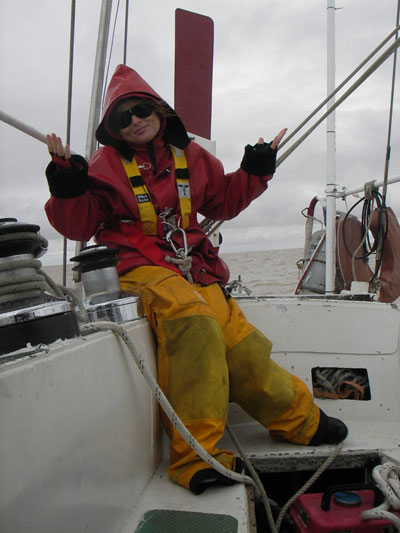 The weather could not make up its mind on our sail from La Plata, Argentina to Montevideo, Uruguay. It was windy, it was calm, it was rainy, it was sunny. In the photo, Karina is expressing her opinion of what the weather will do next. For most of the day, it was constant changes in the amount of sail we had up, as the winds varied from Force 2-7 (5-30 knots).The Rio de la Plata water was muddy and choppy (because it is shallow, the waves are shorter and steeper) as we sailed. By the end of the day, the low clouds went away and the wind steadied to Force 4-5 (12-20 knots), and the sailing got nicer as night fell. We sailed all night, under a mostly clear and starry sky. The last few hours were mostly spent trying to slow down, as the wind was good and the current was with us, to avoid reaching port during darkness.Shortly after dawn, we dropped sails, unlocked the keel (it is locked in the down position when sailing), and motored into the port of Buceo (Buceo is a wealthy suburb of Montevideo). Buceo is quite shallow, and we kept running aground as we motored over to the mooring buoy that Yacht Club Uruguayo said we could use (there is no room for anchoring). Running aground (at least on soft bottoms) is not a big deal with this boat, as long as you can raise the keel to get free, but it complicates maneuvering, as running aground stops the boat, and freeing the boat by lifting the keel means it is going where the wind pushes until you can gain control with the propellers again.After tying to the mooring, we went ashore to clear in with the Coast Guard and Immigration, as the weather continued to improve to become a clear, sunny day, with light, pleasant winds, which we enjoyed from the comfort of the very hospitable Yacht Club Uruguayo lounge.
The weather could not make up its mind on our sail from La Plata, Argentina to Montevideo, Uruguay. It was windy, it was calm, it was rainy, it was sunny. In the photo, Karina is expressing her opinion of what the weather will do next. For most of the day, it was constant changes in the amount of sail we had up, as the winds varied from Force 2-7 (5-30 knots).The Rio de la Plata water was muddy and choppy (because it is shallow, the waves are shorter and steeper) as we sailed. By the end of the day, the low clouds went away and the wind steadied to Force 4-5 (12-20 knots), and the sailing got nicer as night fell. We sailed all night, under a mostly clear and starry sky. The last few hours were mostly spent trying to slow down, as the wind was good and the current was with us, to avoid reaching port during darkness.Shortly after dawn, we dropped sails, unlocked the keel (it is locked in the down position when sailing), and motored into the port of Buceo (Buceo is a wealthy suburb of Montevideo). Buceo is quite shallow, and we kept running aground as we motored over to the mooring buoy that Yacht Club Uruguayo said we could use (there is no room for anchoring). Running aground (at least on soft bottoms) is not a big deal with this boat, as long as you can raise the keel to get free, but it complicates maneuvering, as running aground stops the boat, and freeing the boat by lifting the keel means it is going where the wind pushes until you can gain control with the propellers again.After tying to the mooring, we went ashore to clear in with the Coast Guard and Immigration, as the weather continued to improve to become a clear, sunny day, with light, pleasant winds, which we enjoyed from the comfort of the very hospitable Yacht Club Uruguayo lounge.
Monthly Archives: March 2009
Refit work completed
Montevideo, Uruguay
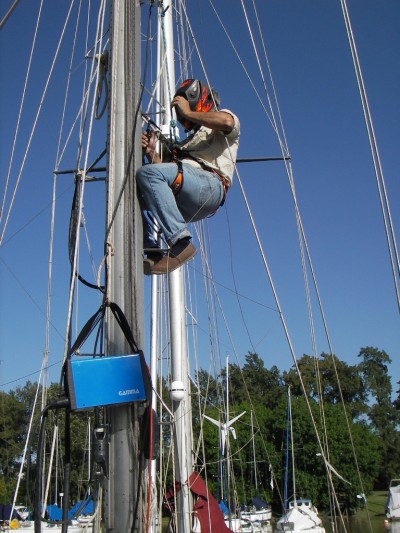 This is a list of the work that was done in Argentina and Uruguay over the last four months. It is probably only of interest to boatowners: * replace main rudder (all steel) * replace auxiliary rudder (all steel, all moving parts stainless steel, new bearings with ondeck grease nipples) * replace keel pulleys (stainless steel, thicker sheaves) * move anchor winch aft, replace hawsepipe (bigger, so chain falls freely to locker), move lower forestay forward to make room * replace overhead/ceiling in pilothouse (mostly done, carpenters abandoned the job and i am finishing it) and starboard amidships area * replace daytank with larger stainless steel one (with drain sump, dedicated gauge line) * replace zinc in engine heat exchanger (looked for but never found one in hydraulic oil cooler) * replace engine fuel filter/water separator with Racor 500 (does same thing as previous unit, but clear bowl makes it much easier to see water in fuel) * add removable platform to cockpit to make it into an outdoor bed/lounging area * replace wind generator with Air Breeze unit (much higher output, and has a stop switch instead of forcing you to climb the pole when it gets too windy) on 4m pole * replace solar panel arch with welded one (not finished yet) * replace several sheet blocks with larger, less-friction ones * move a pair of small winches aft to use with running checkstays (not finished yet) * repair two broken mast steps * replace several sheets and reefing lines * replace bearings in forestaysail (trinquette) rollerfurler, replace bearings in spare rollerfurler (anticipating it will be needed to replace yankee/genoa rollerfurler sometime) * move liferaft from cabintop to deck beside keel for better visibility * have liferaft tested and serviced * replace GPS (broken) with Furuno unit * replace batteries * add shackle point for anchor chain snubber just below bobstay (at waterline) * raise lifelines, replace top wire with welded tubing * disassemble bed in bedroom and remove two water tanks underneath it to repaint where welder burnt paint off welding zincs on outside of hull * remove and reinstall lower port keel adjuster (O-ring had failed and unit had seized) * new yankee, forestaysail (trinquette) and storm jib were made, old yankee and forestaysail (trinquette) had luffs shortened * genoa, main staysail (voile d’etai) and fisherman sails were all cut down a bit to fit the spaces they set in better
This is a list of the work that was done in Argentina and Uruguay over the last four months. It is probably only of interest to boatowners: * replace main rudder (all steel) * replace auxiliary rudder (all steel, all moving parts stainless steel, new bearings with ondeck grease nipples) * replace keel pulleys (stainless steel, thicker sheaves) * move anchor winch aft, replace hawsepipe (bigger, so chain falls freely to locker), move lower forestay forward to make room * replace overhead/ceiling in pilothouse (mostly done, carpenters abandoned the job and i am finishing it) and starboard amidships area * replace daytank with larger stainless steel one (with drain sump, dedicated gauge line) * replace zinc in engine heat exchanger (looked for but never found one in hydraulic oil cooler) * replace engine fuel filter/water separator with Racor 500 (does same thing as previous unit, but clear bowl makes it much easier to see water in fuel) * add removable platform to cockpit to make it into an outdoor bed/lounging area * replace wind generator with Air Breeze unit (much higher output, and has a stop switch instead of forcing you to climb the pole when it gets too windy) on 4m pole * replace solar panel arch with welded one (not finished yet) * replace several sheet blocks with larger, less-friction ones * move a pair of small winches aft to use with running checkstays (not finished yet) * repair two broken mast steps * replace several sheets and reefing lines * replace bearings in forestaysail (trinquette) rollerfurler, replace bearings in spare rollerfurler (anticipating it will be needed to replace yankee/genoa rollerfurler sometime) * move liferaft from cabintop to deck beside keel for better visibility * have liferaft tested and serviced * replace GPS (broken) with Furuno unit * replace batteries * add shackle point for anchor chain snubber just below bobstay (at waterline) * raise lifelines, replace top wire with welded tubing * disassemble bed in bedroom and remove two water tanks underneath it to repaint where welder burnt paint off welding zincs on outside of hull * remove and reinstall lower port keel adjuster (O-ring had failed and unit had seized) * new yankee, forestaysail (trinquette) and storm jib were made, old yankee and forestaysail (trinquette) had luffs shortened * genoa, main staysail (voile d’etai) and fisherman sails were all cut down a bit to fit the spaces they set in better
Higher lifelines
Rio de la Plata, Argentina
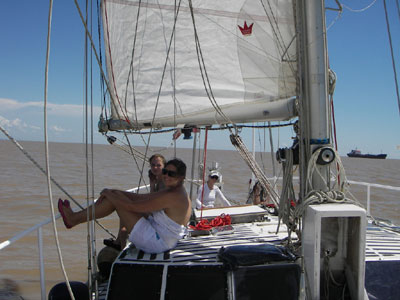 The raised lifeline/liferails are high enough to make tall people feel much more secure walking on deck. They are painted white for better visibility. Some sections have a lower lifeline of rope on them as well. I may extend this…need to do more sailing to confirm the places where sheet leads won’t chafe low lifelines first.
The raised lifeline/liferails are high enough to make tall people feel much more secure walking on deck. They are painted white for better visibility. Some sections have a lower lifeline of rope on them as well. I may extend this…need to do more sailing to confirm the places where sheet leads won’t chafe low lifelines first.
Raising the lifelines
San Fernando, Argentina
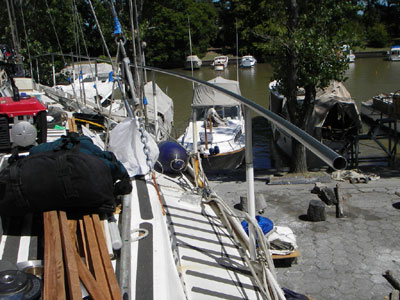 The original wire lifelines were removed and the lifeline stanchions extended. Stainless steel tubing was bent to shape and welded on top of the stanchions to make a higher, more secure liferail.
The original wire lifelines were removed and the lifeline stanchions extended. Stainless steel tubing was bent to shape and welded on top of the stanchions to make a higher, more secure liferail.
La Plata
La Plata, Argentina
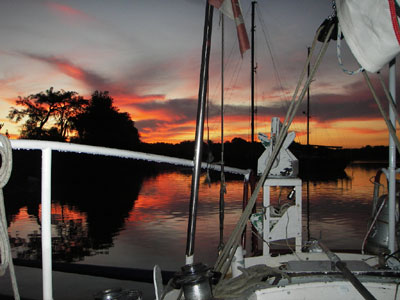 La Plata is a small, relaxed college and refinery city SE of Buenos Aires. There is a good harbor with a fairly narrow entrance that opens up to a long stretch of totally protected water. There is a very friendly yacht club there, Club de Regattas, where we stayed for ten days.
La Plata is a small, relaxed college and refinery city SE of Buenos Aires. There is a good harbor with a fairly narrow entrance that opens up to a long stretch of totally protected water. There is a very friendly yacht club there, Club de Regattas, where we stayed for ten days.
Ship in drydock
La Plata, Argentina
 Didn’t catch the name of this ship in drydock in La Plata, but it looks impressive.
Didn’t catch the name of this ship in drydock in La Plata, but it looks impressive.
Finally sailing again!
La Plata, Argentina
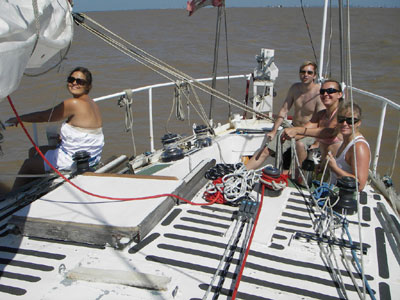 After three months of repairs and modifications, Issuma is finally sailing again. Still a bunch of things to finish, but it is really nice to have a boat capable of sailing again. The picture was taken on a pleasant, sunny, daysail from Buenos Aires to La Plata.
After three months of repairs and modifications, Issuma is finally sailing again. Still a bunch of things to finish, but it is really nice to have a boat capable of sailing again. The picture was taken on a pleasant, sunny, daysail from Buenos Aires to La Plata.